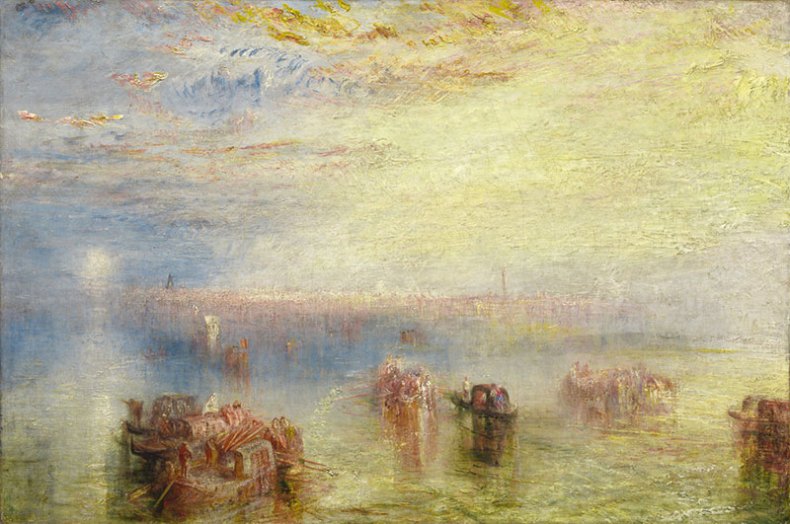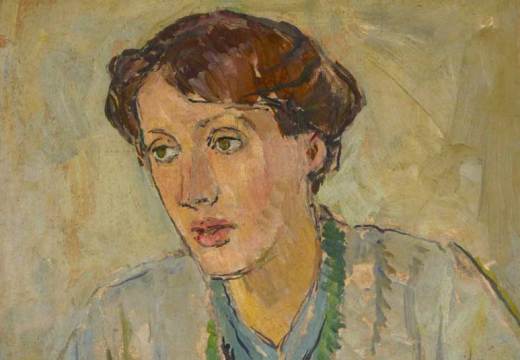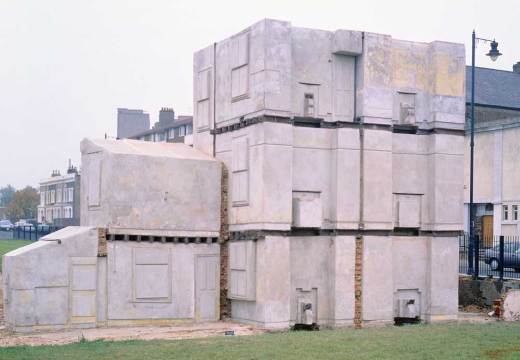J.M.W. Turner is the most protean of artists. His art has an elusive quality, resisting easy definition, and taking its shape from whatever category, comparison or context it is placed within: Turner and the Sea, Turner and Claude, Turner-Monet-Twombly, Turner and the Masters, to name a few recent examples. And his legacy has so often been distorted by anachronism – Turner the proto-Impressionist or Turner the Abstract Expressionist – the all-purpose artist, plugging the gaps in British Modernism.
One of the achievements of the current exhibition at Tate Britain, ‘Late Turner: Painting Set Free’, is to bring us back to the artist himself, to allow us to see his art on its own terms again. A comprehensive survey of the last part of his career, from when he turned 60 in 1835 to his final exhibited works in 1850, it is the first major exhibition to address Turner’s late period. And it is not painting that is set free here, but Turner the painter, liberated from the often questionable roles into which he has been conscripted in the name of British art.
 The Turner we discover is an ageing artist who nevertheless remained committed to the act of painting, and to continual experimentation in oil and watercolour, creating dramatic compositions in which his painterly touch exceeds representational clarity. But this was a path that took him away from the strict standards of draughtsmanship and lucid finishing demanded by contemporary taste, and invited abuse from the critics for whom Turner’s swirling compositions and loose handling of paint were the symptoms of senility and mental decay.
The Turner we discover is an ageing artist who nevertheless remained committed to the act of painting, and to continual experimentation in oil and watercolour, creating dramatic compositions in which his painterly touch exceeds representational clarity. But this was a path that took him away from the strict standards of draughtsmanship and lucid finishing demanded by contemporary taste, and invited abuse from the critics for whom Turner’s swirling compositions and loose handling of paint were the symptoms of senility and mental decay.
Despite adverse criticism, Turner did not retreat into introspection, but kept up a lively engagement with his fellow artists, with the Royal Academy, and with exhibition audiences up until his final years. He made a public performance of painting, exploiting the varnishing days before an exhibition opened to develop and re-work compositions as they hung on the gallery wall, a bravura practice that drew even more ire from his detractors.

Approach to Venice (1844), J.M.W. Turner. Courtesy National Gallery of Art, Washington
Click here for the curator’s introduction to this exhibition
He continued to travel widely in Europe, making his last trip to the continent in 1845, when he was 70. The plein-air watercolour studies from these tours reveal a preoccupation with capturing the fleeting effects of the weather, changing sunlight and reflections on water. Venice’s melancholy faded magnificence retained its hold on the elderly Turner’s imagination long after his final visit in 1840. In works such as Approach to Venice, on loan from the National Gallery of Art, Washington, the city is a haunting presence, suspended between sea and sky, between the visible and the invisible.
The scale and scope of the exhibition is impressive, with the curators drawing on the vast resources of the Turner Bequest, the hundreds of oils and many thousands of drawings that came from the artist’s studio after his death. A wide selection of sketches, studies and preliminary paintings hang alongside the exhibited canvases, revealing the dialogue between Turner’s studio practice and his public art.

The Blue Rigi (1841–2), J.M.W. Turner. Tate. Accepted by the nation as part of the Turner Bequest 1856
In his watercolour studies the artist explored the translucent potential of the medium, conjuring up ever more ethereal evocations of shadows on mountains, sunlight through vapour or watery reflections. The exquisitely luminous 1842 watercolour, The Blue Rigi, Sunrise, is shown here next to the studio sample studies Turner used to advertise the composition to collectors.
Each work lies somewhere on a continuum between the preparatory sketch and something fit for the public eye. But as his antics on varnishing days indicate, he had a fluid concept of when a painting was ‘finished’. All were works-in-progress, and he would revisit earlier compositions later in life, looking for new possibilities with the paint.
Norham Castle, Sunrise is one of the unexhibited oil studies from Turner’s studio, a reworking of a much earlier landscape composition that the artist had published as a mezzotint. Under his brush, oil paint has taken on the transparent quality of watercolour, layered in thin, watery glazes that seem to flow and pool across the surface of the canvas. All that was solid in the earlier composition has melted into air and water, bathed in the golden glow of sunlight.
Did he ever intend this to be a finished work? We can never know. But the message of the exhibition is that this is the wrong question to ask. Turner’s art never reaches conclusions; it is a slippery, fugitive thing. Rather than seeking neat resolutions, sometimes we just have to go with the flow of Turner’s unbound creativity.
‘Late Turner: Painting Set Free’ is at Tate Britain until 25 January 2015.
Related Articles
First Look: ‘The EY Exhibition: Late Turner – Painting Set Free’ at Tate Britain (David Blayney Brown)
Poetic Painters: Turner and Helen Frankenthaler at Turner Contemporary (Corinna Lotz)
First Look: Turner and the Sea (Christine Riding)














![Masterpiece [Re]discovery 2022. Photo: Ben Fisher Photography, courtesy of Masterpiece London](http://zephr.apollo-magazine.com/wp-content/uploads/2022/07/MPL2022_4263.jpg)
‘Like landscape, his objects seem to breathe’: Gordon Baldwin (1932–2025)